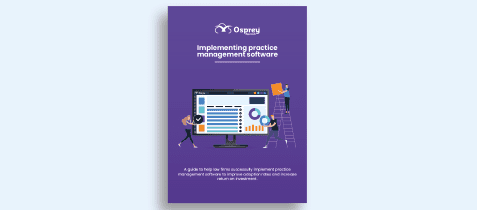Contents
A guide to legal software implementation: How to effectively train your staff
Once you’ve successfully implemented a new piece of legal software, the next step is to get your team familiar with the system and its functions. To set yourself up for long-term success you want to maximise the returns on your investments, which means ensuring resource is allocated to utilising the features your technology has to offer and nurturing your team’s talents.

With clear benefits of longevity and profitability for the practice, investing in employee training and development also improves the satisfaction, achievement, and success levels of your team, helping you to retain the best talent. Prioritising a culture of support, progression, and development will help individuals thrive in their role, increasing happiness and retention. To quote Richard Branson:
“Train people well enough so they can leave, treat them well enough so they don’t want to.”
The connection between people and technology
The technology and software solutions you implement can only ever be successful if the people using them are trained, able, and confident. Without the right training, support, and processes in place it’s impossible to achieve the returns you first expected.
To maximise your return on your software investment you need the solution to work hard for your practice, which means your team need to be able to use it to their advantage. Practice and case management solutions, like Osprey Approach, help make running a law firm easier, but without the right software training and knowledge in place, using technology for the first time can become frustrating and will add to – rather than decrease workloads.
As part of our series of building good business habits for a successful law firm, we’re deep diving into the importance of continuous staff training, with tips and advice on implementing the habits into your firm.
The benefits of investing in staff training
We understand that creating a balance between employee training versus billable hours is tricky to manage. However, this builds the foundation for longevity and the rewards, advantages, and opportunities that will be presented to you long-term outweighs the initial cost of resource, helping to future-proof your firm.
We’ve outlined five key benefits of investing in, and prioritising staff training and knowledge development that will positively impact the long-term success of your firm.
1. Employee satisfaction and staff retention
When employees are confident using the software solutions in place it enables them to take advantage of the technology to reduce the pressure of their workload and make their daily tasks easier to manage, which leads to improved job satisfaction. This will help you to retain your top talent and a great reason for people to join your team.
2. Maximise your return on investment
Confident users can better explore and utilise the software’s capabilities to ensure you’re maximising your return on investment. This enables a continuous improvement mindset to be implemented throughout your firm, because users will continue to see ways to adapt processes that makes the software work harder for them or spot opportunities to increase efficiencies or productivity.
3. Reducing risk and staying compliant
Technology helps to standardise tasks to reduce risk and aid compliance. If staff are trained and confident in using the system, they’re more likely to follow processes correctly, helping you to keep your client data safe, reduce financial premiums, and easily follow best practices.
4. Increased visibility and control for management
When everyone is working effectively from the same platform it reduces siloed processes, data, and documents. This provides partners and stakeholders with better visibility and control over operations and performance because everything is integrated, offering a single source of truth. With a connected and centralised software solution, data-driven insight can be utilised to improve performance, reduce risk, and drive the business forward.
5. Client satisfaction
Client expectations are higher than ever, which means legal practices need to lean on technology to be able to deliver a modern, efficient, and convenient service. Teams can provide an enhanced, competitive service when utilising technology to send timely updates, collaborate digitally, and stay connected.
Five key tips for implementing effective training that will benefit your team and your bottom-line
We know encouraging individuals to take additional training and finding the time to fit it in around busy schedules can be difficult – impossible sometimes. So, to help implement effective training programmes into your firm we spoke to our Product Advisor & Workflows Developer, Alex Hiscutt, who is a non-practicing solicitor with first-hand experience of managing the balance.
1. Clearly communicate goals, objectives, and benefits
Before embarking on implementing a training plan or programme, ensure the goals of your firm are clearly communicated. This helps to align the team’s focus on the same objectives.
Next, it’s important to clearly communicate the benefits for the team. Any change to normal processes can be overwhelming for some, but clearly discussing the benefit of the new processes, software or training can help alleviate those fears and enable staff to appreciate how they will directly benefit and contribute.
Finally, include the team in building out the new training plan to understand what daily challenges individuals face and what they need the software to do for them to make their workloads easier to manage.
A short brainstorming session, with small groups according to department and job role, will help to uncover the common problems. By collaborating on these requirements, tailored plans can be created that will maximise the impact of the training, as well as best utilise your firm’s time.
2. Understand current skills levels
Begin with getting a clear understanding of your teams’ current skill levels and knowledge of the software. It’s important to encourage staff to be honest about their skill gaps because regardless of how long an individual has been at the firm, their level of tech and software skills will vary. Even with a good basic knowledge of the software, updates are regularly released, which means new and updated features may not have been introduced or used.
These discussions will form the basis of a training plan and will highlight where an individual is today, where they need to get to achieve theirs and the firm’s goals, and the steps needed to take to get them there.
This activity across the team can also highlight opportunities for collaboration between people or departments where they complement each other’s strengths and weaknesses. This could be someone with many years’ of experience of the firm’s processes being paired with a tch-savvy new starter.
3. Avoid mass training & lengthy sessions
Everyone’s training plan will look different because of the varying levels of skills, needs, experience, and learning preferences. Training your whole firm at the same time can be ineffective but focusing on small groups of staff will help to maximise everyone’s time.
There may be some base-level training, for new starters, that can be implemented as standard, but typically training should be based on a person’s role and their area of law. Similarly, to ensure training is manageable, plan a multi-stage training programme that can be flexible around commitments. This will help set realistic targets and goals to ensure the momentum of training is continued.
4. Set realistic timeframes
Training isn’t always high on the priority list because there will always be a case or a client that is more important. However, the value of setting clear priorities within realistic time frames for individuals’ needs cannot be underestimated.
Trying to learn an entire system is overwhelming and it’s impossible to know where to start. Allocate non-negotiable, short training sessions in your team’s calendars in advance and dedicate time to that activity, as you would a client meeting or court hearing.
5. Collaboration aids success
Setting out and communicating top-level goals and objectives will help to set the foundations for collaboration across the firm and management. It’s crucial that management take a key role in inspiring, motivating, and leading the successful implementation to achieve returns. Collaboration between employees and teams is also encouraged as opposing strengths and weaknesses can aid training and build teamwork.
It’s also important to collaborate with your software partner. By sharing your goals and objectives with your provider, they can suggest key features and best practices to help you reach your goals. A tried and tested method to improve collaboration is to have someone in each team who is an allocated software champion and can be a first port of call for queries; someone who can work directly with the software provider through challenges, understand best practices, and fully utilise the solution’s features.
There is always value in continuous training
A continuous improvements mindset will ensure your firm is always striving for better, helping you achieve your firm’s goals and remain competitive. When the world of law, technology, and software is always changing, it’s important to continue to review, improve upon and implement new training to stay relevant.
Find out if Osprey Approach is the right solution for your law firm and book a free consultation today with our product experts and discover the financial benefits for your law firm.
For more information on implementing legal software at your law firm, check out all parts of our legal implementation guide:
Part 1 – 6 implementation FAQs answered
Part 2 – 7 factors that impact the length of software implementation
Part 3 – How to simplify data migration
Part 4 – How much does legal software cost?




